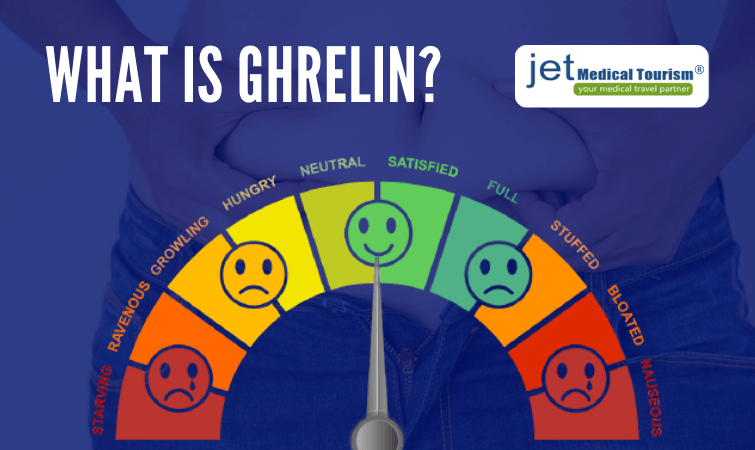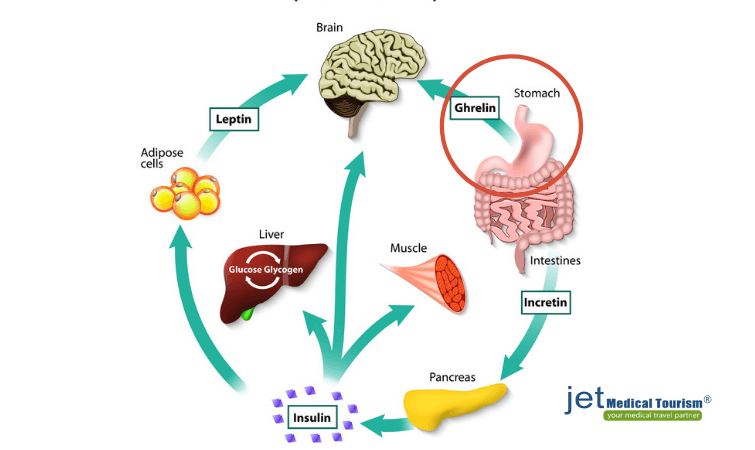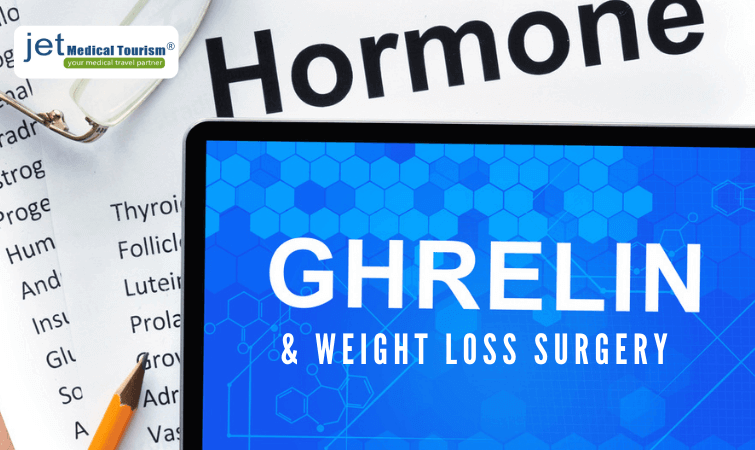What is Ghrelin?

What is ghrelin? Ghrelin is a hormone that controls how hungry people feel. When the sensation of hunger is brought on in the body, this causes a person to feel the urge to eat. The main area of the body where ghrelin is mass-produced is located in the upper lining of the stomach, which medically speaking is called the fundus. Food intake triggers ghrelin. In general, in healthy weight individuals, the higher the ghrelin level, the more hunger sensations that they tend to experience.
Ghrelin levels are problematic or abnormal in individuals suffering from obesity. Obese individuals often seek out methods to become healthy again and the most successful long-term methods of controlling obesity involve those of which are able to reduce the hormone ghrelin. Surgery can reduce ghrelin. More specifically, gastric bypass surgery can effectively reduce ghrelin levels. Furthermore, there are other kinds of weight loss surgery that can also be used to lower ghrelin levels, such as the gastric sleeve surgery or the duodenal switch.
Lap band is another type of weight loss surgery, but has not shown the same effectiveness in reducing ghrelin like gastric bypass or the sleeve due to the Lap band’s ability to only temporarily impair ghrelin function. Contact us today.
What is ghrelin and what is its function?
 Ghrelin is an important hormone that works to control a person’s hunger level, which ultimately impacts their metabolism, and leads to weight gain. The human body has hormones that work as messengers to control many natural bodily functions humans themselves do not need to think about performing due to the presence of the autonomic nervous system.
Ghrelin is an important hormone that works to control a person’s hunger level, which ultimately impacts their metabolism, and leads to weight gain. The human body has hormones that work as messengers to control many natural bodily functions humans themselves do not need to think about performing due to the presence of the autonomic nervous system.
Hormones are released from ductless glands in the body powered by the endocrine system connecting parts of the brain to organs (many found in the digestive system).
The function of ghrelin is mainly to tell a person they are hungry and it is time for them to eat a meal. Studies have shown ghrelin plays a key role in obesity.
- Inside the body of an obese individual, what happens is quite different than that of an individual of normal weight as previously described. Inside the body of an obese individual, ghrelin hormone levels tend to remain low, which is a hormonal disorder or disturbance in their normal hormone levels.
- Before and after an obese individual has a meal, their brain can not tell the rest of their body they are full since their ghrelin levels do not rise and fall enough to distinguish the starting/stopping of the hunger effect as it functions so well in healthy weight individuals.
In the year 1999, researchers first discovered ghrelin and its role in hunger sensations. Researchers also learned ghrelin plays major roles in energy metabolism that led to more studies to be done gaining a deeper understanding of its function. The research revealed ghrelin has many functions.
Ghrelin is found within a small number of organs of the digestive system that communicate with parts of the brain to carry out several functions. The roles of ghrelin include, but are not limited to:
- Promoting the feeling of hunger
- Controlling the sleep/wake cycle
- Controlling metabolism (involving glucose/energy)
- Increasing the release of gastric acid in the stomach
- Promoting the sensation of taste
- Promoting reward-seeking behavior (similar to drug abuse)
- Promoting the gut to move or contract
- Controlling cardiac (heart) functions
- Controlling stress, depression, and anxiety
- Controlling memory/learning
- Controlling fat storage
- Controlling the release of the growth hormone and other hormones, such as cortisol
Even though ghrelin is known for its many bodily roles, the role it is most famous for is in promoting hunger. By thus, the hormone ghrelin works to control the amount of food a person chooses to take in their body, ultimately controlling their metabolism, and promoting weight gain if off-balanced as it is in obese individuals.
REALTED: Ghrelin vs leptin: Impact of hunger hormones on obesity
Where is ghrelin produced?
The fundus is where ghrelin mainly promotes the feeling of hunger by contracting the upper muscle lining of the stomach. Contractions of the fundus work to send hunger signals to the brain. Brain hunger signals or messages the brain receives from the stomach is what tells a person they are feeling hungry and it is time to eat a meal. The more hunger messages felt by a person, the more that person will want to eat more food.
- In far lesser quantities, ghrelin is also made in other bodily areas such as the: small intestines, kidneys, pancreas, lungs, brain and even the placenta among a few other minor areas.
What triggers ghrelin?

Ghrelin serves as a hunger indicator for the body. Basically telling a person when and when not to eat depending on the state of the ghrelin levels in the body, ghrelin levels are dependent upon the intake of food. In healthy weight individuals, how ghrelin works is when the stomach is empty (before a meal), this triggers the upper lining of the stomach (the fundus) to contract.
- Once the fundus contracts, this is the area of the body predominantly known to produce ghrelin, the stomach contractions send messages to the brain that this person is hungry and in need of more food. So ghrelin levels increase or spike.
- After a healthy weight individual has a meal, ghrelin levels drop drastically as a normal physical response inside the body. However in obese individuals, ghrelin works differently. This is because in obese individuals, there is a hormonal disorder in controlling ghrelin.
- The severity of abnormalities caused by hormones can depend on how disrupted the current hormone level is from its normal level.
- Ghrelin levels in healthy weight individuals are highest before meals, telling the body a person is hungry. After a person has a meal, ghrelin levels drop drastically, telling the body this person is full and no longer craving a meal.
- The brain of an obese individual stays in a mindset of starvation. The brain is constantly telling the person they are hungry and in need of more food, even after the person has consumed a large quantity of food.
- Despite what most people may be prone to believe about ghrelin levels based on known data on healthy weight individuals, ghrelin levels among the obese remain low. This means before and after meals there is very little to almost no difference in ghrelin levels in obese individuals.
- This is problematic since it creates an unknown sense of when to stop eating.
- Inside the body of obese individuals, this environment is similar to a state of starvation (but only existing in the mind), where the brain of the obese individual is constantly being told it is still hungry and in need of more food, regardless of the quantity of food already consumed.
How to reduce ghrelin?
A surgery such as the gastric sleeve (also known as the sleeve gastrectomy) has been shown to be most effective in reducing ghrelin levels. Studies have shown gastric sleeve surgery can drastically decrease ghrelin levels for up to two years after surgery.
- Even diet and exercise are not able to reduce ghrelin levels enough to prevent an obese individual from feeling strong hunger sensations.
- This is one common cause of weight gain relapse occurring when people only depend on diet and exercise to try to achieve long-term weight loss.
- However, people may have a genetic susceptibility to obesity to cause them to crave higher calorie foods or become obese. Such people may be prone to imbalanced ghrelin levels. A known familial genetic susceptibility to obesity may influence the long-term success rate for a patient’s weight loss goals after bariatric surgery.
Ghrelin and weight loss surgery

The hunger hormone, ghrelin is drastically reduced after weight loss surgery such as gastric sleeve, gastric bypass, etc. The reason that weight loss surgery reduces ghrelin is due to the removal of the large upper portion of the stomach, known as the fundus. The fundus is the upper lining of the stomach and its immediate surrounding areas. This is where the highest ghrelin levels in the body are produced.
Since ghrelin promotes hunger in the body, removing the fundus is essential to removing the majority of a person’s hunger sensations. Removing the stomach’s fundus will cause a person to eat less after weight loss surgery since the person will no longer be overwhelmed by hunger sensations they previously experienced before having done bariatric surgery.
- With bariatric surgery comes long-term maintenance of low ghrelin levels, allowing the patient to ultimately feel less hunger, hence eating far less than prior to having completed bariatric surgery.
- Ghrelin has been shown to be linked to emotional overeating as well since this hunger hormone sends messages to a part of the brain responsible for reward processing (this area of the brain is called the amygdala).
Weight loss surgery occurs when a physician operates on a patient’s stomach to alter the size of it in order to reduce a person’s current weight and to allow the patient to continue to lose weight after the surgery has been completed. Bariatric surgery works to limit the amount of food a person’s stomach is capable of holding, limiting nutrient absorption. There are several common types of weight loss surgery used worldwide such as:
- Gastric sleeve surgery: Also known as VSG surgery of vertical sleeve gastrectomy is a newer worldwide preferred surgical procedure to surgically remove about 85% of the stomach so less food can be consumed by the patient.
- Gastric bypass surgery: The oldest bariatric surgery performed today that limits food portion size since a surgeon cuts the stomach into a small pouch and combines it with the small intestine directly to avoid food processing into the stomach and avoids nutrient absorption.
- Lap-band surgery: Also known as gastric banding, this procedure came after the gastric bypass, but earlier than the gastric sleeve. Gastric banding involves a surgeon inserting a band made of silicone over the top part of a patient’s stomach which can be adjusted in size. However, since Lap-Band does not surgically cut the stomach to permanently alter its size, ghrelin levels are not impacted as much with this type of weight loss surgery.
- Duodenal switch surgery: This surgical procedure decreases the stomach size by first having a gastric sleeve done, followed by rerouting food from the newly formed small “sleeve” stomach to the initial part of the small intestines (called the duodenum). The duodenal switch has been proven the most effective surgery for severely obese patients (those with a BMI or body mass index over 50) in maintaining long-term weight loss. The higher a person’s BMI becomes, the greater their chance of being overweight or at higher levels, a BMI can develop into obesity.
Does gastric bypass reduce ghrelin?
Gastric bypass surgery reduces ghrelin levels since it cuts out a large portion of the stomach where the majority of ghrelin is produced. This type of weight loss surgery also serves to modify hormone balance, increasing leptin production. Leptin is a hormone that controls how full a person feels after a meal. Since the hormone leptin often combats the hormone ghrelin when controlling hunger, ghrelin levels become reduced with gastric bypass surgery.
Reduced ghrelin levels may work to restore the balance in ghrelin to allow a person after surgery to start experiencing a sense of hunger versus when to stop eating or feeling full. It is a positive benefit that gastric bypass surgery can still allow a person to maintain some ghrelin levels to still be able to feel hunger, while at the same time, reducing those strong hunger sensations by reducing ghrelin levels.
References:
- Mandal, Ananya, M.D. News-Medical, life sciences. What are hormones? 2019. Accessed: 27, Oct. 2020. Web. https://www.news-medical.net/health/What-are-Hormones.aspx.
- Müller TD, Nogueiras R, Andermann ML, Andrews ZB, Anker SD, Argente J, et al. (June 2015). “Ghrelin”. Molecular Metabolism. 4 (6): 437–60. doi:10.1016/j.molmet.2015.03.005.
- Iannelli, A., Dainese, R., Piche, T., Facchiano, E., & Gugenheim, J. (2008). Laparoscopic sleeve gastrectomy for morbid obesity. World journal of gastroenterology, 14(6), 821–827. https://doi.org/10.3748/wjg.14.821
- Hamman, Nathan. OSF Healthcare. What are the three different types of weight loss surgeries? 2013. Assessed: 27, Oct. 2020. Web. https://www.osfhealthcare.org/blog/what-are-the-three-different-types-of-weight-loss-surgery/.
- The Johns Hopkins University. BPD/DS weight-loss surgery. 2020. Accessed: 27, Oct. 2020. Web. https://www.hopkinsmedicine.org/health/treatment-tests-and-therapies/bpdds-weightloss-surgery.
- Olbers T, Björkman S, Lindroos A, et al. Body composition, dietary intake, and energy expenditure after laparoscopic Roux-en-Y gastric bypass and laparoscopic vertical banded gastroplasty. Ann Surg. 2006; 244:715–22.

